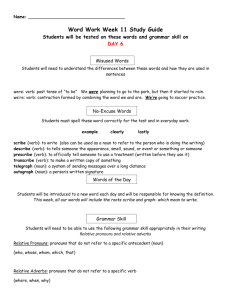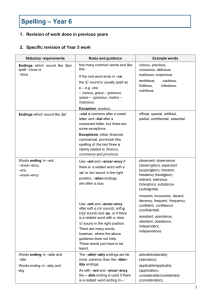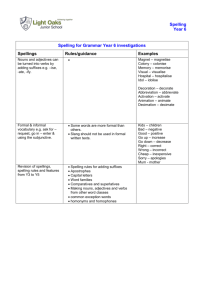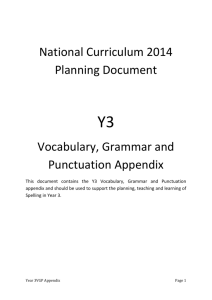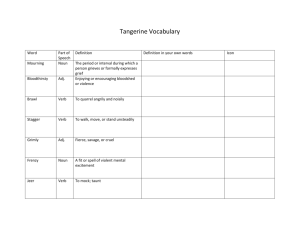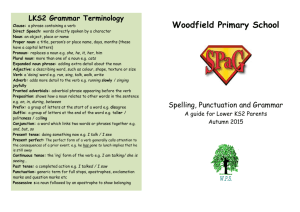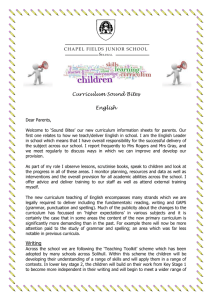English - Year 7, 8 and 9
advertisement
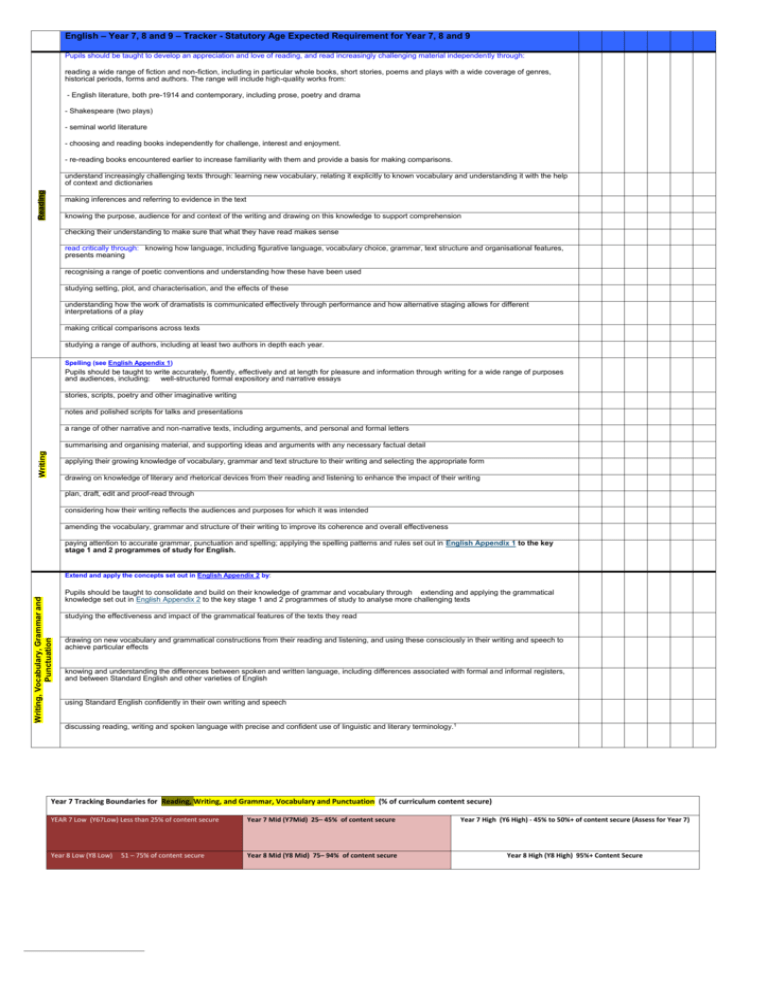
English – Year 7, 8 and 9 – Tracker - Statutory Age Expected Requirement for Year 7, 8 and 9 Pupils should be taught to develop an appreciation and love of reading, and read increasingly challenging material independently through: reading a wide range of fiction and non-fiction, including in particular whole books, short stories, poems and plays with a wide coverage of genres, historical periods, forms and authors. The range will include high-quality works from: - English literature, both pre-1914 and contemporary, including prose, poetry and drama - Shakespeare (two plays) - seminal world literature - choosing and reading books independently for challenge, interest and enjoyment. - re-reading books encountered earlier to increase familiarity with them and provide a basis for making comparisons. Reading understand increasingly challenging texts through: learning new vocabulary, relating it explicitly to known vocabulary and understanding it with the help of context and dictionaries making inferences and referring to evidence in the text knowing the purpose, audience for and context of the writing and drawing on this knowledge to support comprehension checking their understanding to make sure that what they have read makes sense read critically through: knowing how language, including figurative language, vocabulary choice, grammar, text structure and organisational features, presents meaning recognising a range of poetic conventions and understanding how these have been used studying setting, plot, and characterisation, and the effects of these understanding how the work of dramatists is communicated effectively through performance and how alternative staging allows for different interpretations of a play making critical comparisons across texts studying a range of authors, including at least two authors in depth each year. Spelling (see English Appendix 1) Pupils should be taught to write accurately, fluently, effectively and at length for pleasure and information through writing for a wide range of purposes and audiences, including: well-structured formal expository and narrative essays stories, scripts, poetry and other imaginative writing notes and polished scripts for talks and presentations a range of other narrative and non-narrative texts, including arguments, and personal and formal letters Writing summarising and organising material, and supporting ideas and arguments with any necessary factual detail applying their growing knowledge of vocabulary, grammar and text structure to their writing and selecting the appropriate form drawing on knowledge of literary and rhetorical devices from their reading and listening to enhance the impact of their writing plan, draft, edit and proof-read through considering how their writing reflects the audiences and purposes for which it was intended amending the vocabulary, grammar and structure of their writing to improve its coherence and overall effectiveness paying attention to accurate grammar, punctuation and spelling; applying the spelling patterns and rules set out in English Appendix 1 to the key stage 1 and 2 programmes of study for English. Writing, Vocabulary, Grammar and Punctuation Extend and apply the concepts set out in English Appendix 2 by: Pupils should be taught to consolidate and build on their knowledge of grammar and vocabulary through extending and applying the grammatical knowledge set out in English Appendix 2 to the key stage 1 and 2 programmes of study to analyse more challenging texts studying the effectiveness and impact of the grammatical features of the texts they read drawing on new vocabulary and grammatical constructions from their reading and listening, and using these consciously in their writing and speech to achieve particular effects knowing and understanding the differences between spoken and written language, including differences associated with formal and informal registers, and between Standard English and other varieties of English using Standard English confidently in their own writing and speech discussing reading, writing and spoken language with precise and confident use of linguistic and literary terminology.1 Year 7 Tracking Boundaries for Reading, Writing, and Grammar, Vocabulary and Punctuation (% of curriculum content secure) YEAR 7 Low (Y67Low) Less than 25% of content secure Year 7 Mid (Y7Mid) 25– 45% of content secure Year 7 High (Y6 High) - 45% to 50%+ of content secure (Assess for Year 7) Year 8 Low (Y8 Low) Year 8 Mid (Y8 Mid) 75– 94% of content secure Year 8 High (Y8 High) 95%+ Content Secure 51 – 75% of content secure APPENDIX 1 – Years 7, 8 and 9- Spelling (Reinforce, apply and extend use of all previous patterns) Statutory Requirement Rules and Guidance (All children should be able to understand the Grammar and Punctuation in Endings which sound like /ʃəs/ spelt –cious or – tious Not many common words end like this. If the root word ends in –ce, the /ʃ/ sound is usually spelt as c – e.g. vice – vicious, grace – gracious, space – spacious, malice – malicious. Example Words Years 1 to 4 in addition to the below) vicious, precious, conscious, delicious, malicious, suspicious ambitious, cautious, fictitious, infectious, nutritious Exception: anxious. Endings which sound like /ʃəl/ Words ending in –ant, –ance/–ancy, –ent, –ence/–ency –cial is common after a vowel letter and –tial after a consonant letter, but there are some exceptions. Exceptions: initial, financial, commercial, provincial (the spelling of the last three is clearly related to finance, commerce and province). Use –ant and –ance/–ancy if there is a related word with a /æ/ or /eɪ/ sound in the right position; –ation endings are often a clue. Use –ent and –ence/–ency after soft c (/s/ sound), soft g (/dʒ/ sound) and qu, or if there is a related word with a clear /ɛ/ sound in the right position. There are many words, however, where the above guidance does not help. These words just have to be learnt. If the –able ending is added to a word ending in –ce or –ge, the e after the c or g must be kept as those letters would otherwise have their ‘hard’ sounds (as in cap and gap) before the a of the –able ending. // The –able ending is usually but not always used if a complete root word can be heard before it, even if there is no related word ending in –ation. The first five examples opposite are obvious; in reliable, the complete word rely is heard, but the y changes to i in accordance with the rule. // The –ible ending is common if a complete root word can’t be heard before it but it also sometimes occurs when a complete word can be heard (e.g. sensible). official, special, artificial, partial, confidential, essential observant, observance, (observation), expectant (expectation), hesitant, hesitancy (hesitation), tolerant, tolerance (toleration), substance (substantial) innocent, innocence, decent, decency, frequent, frequency, confident, confidence (confidential) assistant, assistance, obedient, obedience, independent, independence Words ending in –able and –ible Words ending in –ably and –ibly The –able/–ably endings are far more common than the –ible/–ibly endings. As with –ant and –ance/–ancy, the –able ending is used if there is a related word ending in –ation. adorable/adorably (adoration), applicable/applicably (application), considerable/considerably (consideration), tolerable/tolerably (toleration) changeable, noticeable, forcible, legible dependable, comfortable, understandable, reasonable, enjoyable, reliable possible/possibly, horrible/horribly, terrible/terribly, visible/visibly, incredible/incredibly, sensible/sensibly Adding suffixes beginning with vowel letters to words ending in –fer The r is doubled if the –fer is still stressed when the ending is added. referring, referred, referral, preferring, preferred, transferring, transferred reference, referee, preference, transference Use of the hyphen Hyphens can be used to join a prefix to a root word, especially if the prefix ends in a vowel letter and the root word also begins with one. co-ordinate, re-enter, co-operate, co-own Words with the /i:/ sound spelt ei after c The ‘i before e except after c’ rule applies to words where the sound spelt by ei is /i:/. Exceptions: protein, caffeine, seize (and either and neither if pronounced with an initial /i:/ sound). deceive, conceive, receive, perceive, ceiling Words containing the letter-string ough ough is one of the trickiest spellings in English – it can be used to spell a number of different sounds. ought, bought, thought, nought, brought, fought, rough, tough, enough, cough though, although, dough, through thorough, borough /// plough, bough Words with ‘silent’ letters (i.e. letters whose presence cannot be predicted from the pronunciation of the word) doubt, island, lamb, solemn, thistle, knight The r is not doubled if the –fer is no longer stressed. Some letters which are no longer sounded used to be sounded hundreds of years ago: e.g. in knight, there was a /k/ sound before the /n/, and the gh used to represent the sound that ‘ch’ now represents in the Scottish word loch. Homophones and other words that are often confused In the pairs of words opposite, nouns end –ce and verbs end –se. Advice and advise provide a useful clue as the word advise (verb) is pronounced with a /z/ sound – which could not be spelt c. More examples: aisle: a gangway between seats (in a church, train, plane). isle: an island. aloud: out loud. allowed: permitted. affect: usually a verb (e.g. The weather may affect our plans). effect: usually a noun (e.g. It may have an effect on our plans). If a verb, it means ‘bring about’ (e.g. He will effect changes in the running of the business). altar: a table-like piece of furniture in a church. alter: to change. ascent: the act of ascending (going up). assent: to agree/agreement (verb and noun). bridal: to do with a bride at a wedding. bridle: reins etc. for controlling a horse. cereal: made from grain (e.g. breakfast cereal). serial: adjective from the noun series – a succession of things one after the other. compliment: to make nice remarks about someone (verb) or the remark that is made (noun). complement: related to the word complete – to make something complete or more complete (e.g. her scarf complemented her outfit). descent: the act of descending (going down). dissent: to disagree/disagreement (verb and noun). desert: as a noun – a barren place (stress on first syllable); as a verb – to abandon (stress on second syllable) dessert: (stress on second syllable) a sweet course after the main course of a meal. draft: noun – a first attempt at writing something; verb – to make the first attempt; also, to draw in someone (e.g. to draft in extra help) draught: a current of air. advice/advise device/devise licence/license practice/practise prophecy/prophesy farther: further father: parent guessed: past tense of the verb guess guest: visitor heard: past tense of the verb hear herd: a group of animals led: past tense of the verb lead lead: present tense of that verb, or else the metal which is very heavy (as heavy as lead) morning: before noon mourning: grieving for someone who has died past: noun or adjective referring to a previous time (e.g. In the past) or preposition or adverb showing place (e.g. he walked past me) passed: past tense of the verb ‘pass’ (e.g. I passed him in the road) precede: go in front of or before proceed: go on principal: adjective – most important (e.g. principal ballerina) noun – important person (e.g. principal of a college) principle: basic truth or belief profit: money that is made in selling things prophet: someone who foretells the future stationary: not moving stationery: paper, envelopes etc. steal: take something that does not belong to you steel: metal wary: cautious weary: tired who’s: contraction of who is or who has whose: belonging to someone (e.g. Whose jacket is that?) Word List – Spellings – Year 7, 8 and 9 (Reinforce, use and apply all previous spellings) accommodate accompany according achieve aggressive amateur ancient apparent appreciate attached available average awkward bargain bruise category cemetery committee communicate community Competition conscience* conscious* controversy convenience correspond criticise (critic + ise) curiosity definite desperate determined develop dictionary disastrous embarrass environment equip (–ped, – ment) especially exaggerate excellent existence explanation familiar foreign forty frequently government guarantee harass hindrance immediate(ly) individual interfere interrupt language leisure lightning marvellous mischievous muscle necessary neighbour nuisance occupy occur opportunity parliament persuade physical prejudice privilege profession programme pronunciation queue recognise recommend relevant restaurant rhyme rhythm sacrifice secretary shoulder signature sincere(ly) soldier stomach sufficient suggest symbol system temperature thorough twelfth variety vegetable vehicle yacht APPENDIX 2 – YEAR 7, 8 and 9– Vocabulary Grammar and Punctuation (Extend and apply all previous rules) Year 3 Appendix 2 Vocabulary, Grammar and Punctuation – Year 6 - (All children should be able to understand the Grammar and Punctuation in Years 1 to 5 in addition to the below) Word The difference between vocabulary typical of informal speech and vocabulary appropriate for formal speech and writing [for example, find out – discover; ask for – request; go in – enter] How words are related by meaning as synonyms and antonyms [for example, big, large, little]. Sentence Use of the passive to affect the presentation of information in a sentence [for example, I broke the window in the greenhouse versus The window in the greenhouse was broken (by me)]. The difference between structures typical of informal speech and structures appropriate for formal speech and writing [for example, the use of question tags: He’s your friend, isn’t he?, or the use of subjunctive forms such as If I were or Were they to come in some very formal writing and speech] Text Linking ideas across paragraphs using a wider range of cohesive devices: repetition of a word or phrase, grammatical connections [for example, the use of adverbials such as on the other hand, in contrast, or as a consequence], and ellipsis Layout devices [for example, headings, sub-headings, columns, bullets, or tables, to structure text] Punctuation Brackets, dashes or commas to indicate parenthesis Use of commas to clarify meaning or avoid ambiguity Use of the semi-colon, colon and dash to mark the boundary between independent clauses [for example, It’s raining; I’m fed up] Use of the colon to introduce a list and use of semi-colons within lists Punctuation of bullet points to list information How hyphens can be used to avoid ambiguity [for example, man eating shark versus man-eating shark, or recover versus re-cover] Terminology preposition conjunction word family, prefix clause, subordinate clause direct speech consonant, consonant letter vowel, vowel letter inverted commas (or ‘speech marks’) determiner, pronoun, possessive pronoun, adverbial modal verb, relative pronoun, relative clause, parenthesis, bracket, dash, cohesion, ambiguity subject, object, active, passive, synonym, antonym, ellipsis, hyphen, colon, semi-colon, bullet points

